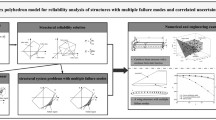Summary
In this paper, a new non-probabilistic set-theoretic safety measure for structures is proposed. Based on the non-probabilistic set-theoretic stress–strength interference model, the ratio of the volume of the safe region to the total volume of the region associated with the variation of the basic interval variables is suggested as the measure of structural non-probabilistic safety. The compatibility between the presented non-probabilistic set-theoretic safety measure and the probabilistic reliability is demonstrated. Numerical examples are used to shed a light on the validity of the presented measure.
Similar content being viewed by others
References
Wang G.Y. (2002). On the development of uncertain structural mechanics. Adv. Mech. 32(2): 205–211 (in Chinese)
Elishakoff I. (1998). Three versions of the finite element method based on concepts of either stochasticity, fuzziness or anti-optimization. Appl. Mech. Rev. 51(3): 209–218
Ben-Haim Y. and Elishakoff I. (1990). Convex Models of Uncertainty in Applied Mechanics. Elsevier, Amsterdam
Elishakoff I. (1994). A new safety factor based on convex modeling. In: Ayyub, B.M. and Gupta, M.M. (eds) Uncertainty Modeling and Analysis: Theory and Applications, pp 145–171. North-Holland, Amsterdam
Ben-Haim Y. (1994). A non-probabilistic concept of reliability. Struct. Saf. 14: 227–245
Elishakoff I. (1995). Discussion on: A non-probabilistic concept of reliability. Struct. Saf. 17(3): 195–199
Good I.J. (1995). Reliability always depends on probability of course. J. Stat. Comput. Simul. 52: 192–193
Good I.J. (1996). Reply to Prof. Y. Ben-Haim. J. Stat. Comput. Simul. 55: 265–266
Cai K.Y., Wen C.Y. and Zhang M.L. (1991). Fuzzy variables as a basis for a theory of fuzzy reliability in the possibility context. Fuzzy Sets Syst. 42(2): 145–172
Chowdhury S.G. and Misra K.B. (1992). Evalutation of fuzzy reliability of a non-series parallel network. Microelectron. Reliab. 32: 1–4
Vinot P., Cogan S. and Lallement G. (2003). Approche non-probabiliste de fiabilité basée sur les modèles convexes. Mec. Ind. 4(1): 45–50
Wang X.J. and Qiu Z.P. (2003). Robust reliability of structural vibration. J. Beijing Univ. Aeronaut. Astronaut 29(11): 1006–1010 (in Chinese)
Qiu Z.P., Chen S.Q. and Wang X.J. (2004). Criterion of the non-probabilistic robust reliability for structures. Chin. J. Comput. Mech. 21(1): 1–6 (in Chinese)
Qiu Z.P., Müller P.C. and Frommer A. (2004). The new non-probabilistic criterion of failure for dynamical systems based on convex models. Math. Comput. Model. 40(1–2): 201–215
Guo S.X., Lu Z.Z. and Feng Y.S. (2001). A non-probabilistic model of structural reliability based on interval analysis. Chin. J. Comput. Mech. 18(1): 56–60 (in Chinese)
Moore R.E. (1979). Methods and Applications of Interval Analysis. SIAM, Philadelphia
Alefeld G. and Herzberger J. (1983). Introduction to Interval Computations. Academic, New York
Qiu Z.P. and Wang X.J. (2005). Parameter perturbation method for dynamic responses of structures with uncertain-but-bounded parameters based on interval analysis. Int. J. Solids Struct. 42(18–19): 4985–4970
Qiu Z.P., Wang X.J. and Friswell M.I. (2005). Eigenvalue bounds of structures with uncertain-but-bounded parameters. J. Sound Vibr. 282: 297–312
Elishakoff I. (2004). Safety Factors and Reliablity: Friends or Foes? Kluwer, Dordercht
Elishakoff I. and Ferracuti B. (2006). Four alternative definitions of the fuzzy safety factor. J. Aerospace Engng. 19(4): 281–287
Elishakoff I. and Ferracuti B. (2006). Fuzzy sets based interpretation of the safety factor. Fuzzy Sets Syst. 157(18): 2495–2512
Freudenthal A.M. (1938). Allowable stresses and safety of structures. J. Assoc. Engng. Israel 1: 149–153 (in Hebrew)
Freudenthal A.M. (1956). Safety and probability of structural failure. Trans. ASCE 121: 1337–1375
Author information
Authors and Affiliations
Corresponding author
Rights and permissions
About this article
Cite this article
Wang, X., Qiu, Z. & Elishakoff, I. Non-probabilistic set-theoretic model for structural safety measure. Acta Mech 198, 51–64 (2008). https://doi.org/10.1007/s00707-007-0518-9
Received:
Accepted:
Published:
Issue Date:
DOI: https://doi.org/10.1007/s00707-007-0518-9




